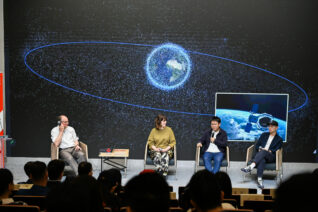Jean-Paul Kneib
The opening symposium of the exhibition, serving as the prelude to this special exhibition, will feature three collaborative curators, participating artists, and academic partners of the exhibition — the Department of Astronomy at Tsinghua University and the Shanghai Astronomical Observatory of the Chinese Academy of Sciences — to participate in discussions. This will be an in-depth intertwining of art and science, as well as an international dialogue from a broad astronomical perspective.
The forum’s agenda centers on the intersection of science, art, and the cosmos, structured around three thematic discussions. Each curator will deliver a keynote address on their designated topic and act as a moderator, facilitating discussions on space art, public communication of large-scale scientific research projects, and sustainable practices in space exploration.
Session 1 “Astrophysics, Art, and Data: Converging Pathways to Understanding the Universe”: The panel delves into how advancements in data analytics, combined with artistic interpretations and astrophysical research, are shaping our understanding of the universe and inspiring new ways of engaging with cosmic phenomena.
Session 2 “Cosmic Canvas: Artistic Expressions and Scientific Insights”: The panel will discuss the creative and scientific processes that inspire the artists’ works and explores how art can provide unique perspectives on the cosmos, complementing scientific research and fostering interdisciplinary dialogue.
Session 3 “Art, Science, and Space Sustainability: Bridging Worlds through Creativity”: In this session, the diverse panelists will explore the transformative potential of art and creativity in advancing space sustainability and fostering interdisciplinary collaborations between art and science.
The opening forum will collaborate with the Zikawei Library. Throughout history, the spirit of “inquiring about the sky” has been embedded in the cultural genes of Xuhui — the first Far Eastern meteorological observatory, Xujiahui Observatory, and the Shanghai Astronomical Observatory of the Chinese Academy of Sciences have witnessed significant developments in modern Chinese meteorological and astronomical research. Zikawei Library as a landmark library in Shanghai, resonates with the theme and content of this symposium due to its unique geographical location, its connection with astronomy, and its cultural background blending Eastern and Western influences.
Presented by Shanghai Astronomy Museum, EPFL, the Swiss Federal Institute of Technology in Lausanne, and Swissnex in China, Cosmos Archaeology will bring the latest international achievements at the intersection of art and astronomy to domestic audiences. The exhibition follows the trajectory of light from the vast and distant depths of space to the surface of the Earth. In the six chapters “Edge of the World,” “Deepspace Landscapes,” “Orbital Forests,” “Sky-Gazing Eyes,” “Hidden Pasts of the Cosmos,” and ” Cosmos of the Mind,” each piece weaves a narrative of a certain scale: What is the origin of the universe? How do large astronomical installations gaze into deep space? Can we glimpse our own fate in the cosmos? How are the myths of the sky interpreted in contemporary times? In the exhibition, data and scientific visualizations about the universe are intertwined with cultural imaginations, stories, and philosophical reflections about the universe. They not only translate, reproduce, and interact with the “sky mapping” data drawn from optical sky survey missions such as the Sloan Digital Sky Survey (SDSS) but also include perspectives from the humanities or science fiction related to exploring extraterrestrial civilizations, sustainable space development, and astronomical history.
The artworks featured in “Cosmos Archaeology” primarily result from the close collaboration between the humanities and astronomy. This key exhibits from EPFL is co-created by the EPFL’s Laboratory for Experimental Museology (eM+) and Laboratory of Astrophysics (LASTRO). Additionally, the exhibition highlights collaborations between artists and prominent astronomical projects, including the MUST Telescope from Tsinghua University and the Chinese SKA Science Projects led by the Shanghai Astronomical Observatory.
This exhibition is generously supported by Beijing Yuanzhen Culture Co., Ltd, Presence Switzerland, the Department of Astronomy at Tsinghua University, the Shanghai Astronomical Observatory, Chinese Academy of Sciences, and Swissnex in China.
LEARN MORE ABOUT THE EXHIBITION “COSMOS ARCHAEOLOGY”
Jean-Paul Kneib
Huanyuan Shan
Zheng Shi
Emma Tolley
Iris Long
Song Huang
Shu Cao
Semiconductor
Sarah Kenderdine
Nick Ryan
Cath le Couteur
Pierre Pauze
Xian Song

















